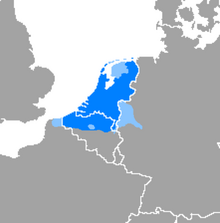Dutch (language)
| Dutch | |
|---|---|
| Nederlands | |
| Pronunciation | [ˈneːdərlɑnts] |
| Native to | Mainly the Netherlands, Belgium, and Suriname; also in Aruba, Curaçao, Sint Maarten, as well as France (French Flanders). |
| Region | Mainly Western Europe, today also in Africa, South America and the Caribbean. |
|
Native speakers
|
23 million (2012) Total (L1 plus L2 speakers): 28 million (2012) |
|
Early forms
|
Old Dutch
|
|
Latin (Dutch alphabet) Dutch Braille |
|
| Signed Dutch (Nederlands met Gebaren) | |
| Official status | |
|
Official language in
|
|
| Regulated by | Nederlandse Taalunie (Dutch Language Union) |
| Language codes | |
| ISO 639-1 | nl |
| ISO 639-2 |
(B) (T)
|
| ISO 639-3 | Variously: nld – Dutch/Flemish vls – West Flemish (Vlaams) zea – Zealandic (Zeeuws) |
| Glottolog | mode1257 |
| Linguasphere | 52-ACB-a (varieties: |

Dutch-speaking world (included are areas of daughter-language Afrikaans)
|
|

Distribution of the Dutch language and its dialects in Western Europe
|
|
Dutch (![]() Nederlands ) is a West Germanic language that is spoken in the European Union by about 23 million people as a first language—including most of the population of the Netherlands and about sixty percent that of Belgium—and by another 5 million as a second language. It is the third most widely spoken Germanic language, after English and German.
Nederlands ) is a West Germanic language that is spoken in the European Union by about 23 million people as a first language—including most of the population of the Netherlands and about sixty percent that of Belgium—and by another 5 million as a second language. It is the third most widely spoken Germanic language, after English and German.
Dutch has developed over the course of 15 centuries.Old Dutch developed from Frankish, as it was spoken by the Salian Franks in the fifth century. Middle Dutch began in the late 11th century with the proliferation of a Medieval Dutch literature. Modern Dutch began in the late 15th century when the first attempts for a Standard language were made. Despite the worldwide influence of the Dutch Empire, modern Dutch spread only moderately around the world from the 17th to mid-20th centuries. Outside of the Low Countries, it is the native language of the majority of the population of Suriname, and also holds official status in Aruba, Curaçao and Sint Maarten, which are constituent countries of the Kingdom of the Netherlands. Historical minorities on the verge of extinction remain in parts of France and Germany, and in Indonesia, while up to half a million native speakers may reside in the United States, Canada and Australia combined. The Cape Dutch dialects of Southern Africa have evolved into Afrikaans, a mutually intelligible daughter language which is spoken to some degree by at least 16 million people, mainly in South Africa and Namibia.
...
Wikipedia
